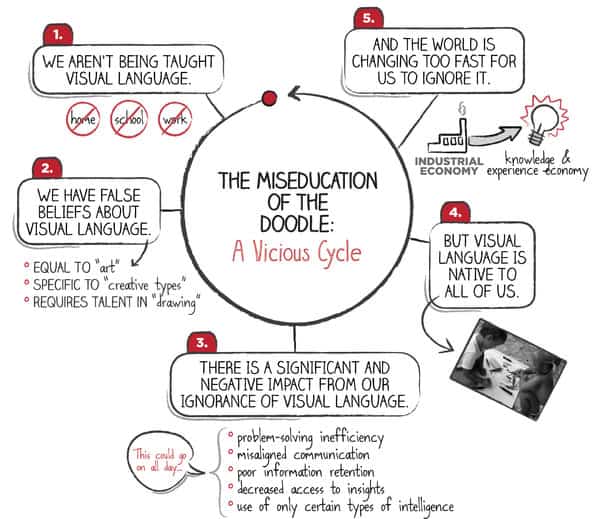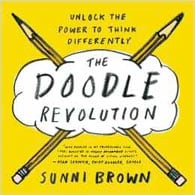When I showed my copy of Sunni Brown’s The Doodle Revolution to a fellow UX designer at the pub recently, her response was: “Don’t you already know that stuff?”
The answer is: No. Sure, I can sketch, and draw—I even do a bit of freelance illustration. So some of the exercises at the start of the book designed to coax hesitant doodlers out of their self-imposed hiatus weren’t really for me.
However, once you’re past those introductory activities, this is not a book about how to draw. It’s a book about how to extend and leverage your visual literacy to solve problems in creative ways—and to empower your workmates to do the same. It’s like a cross between Mike Rohde’s The Sketchnote Handbook, the video course of which we reviewed earlier this week, and Gamestorming, a book about collaborative design games of which Brown is also a co-author.
Getting all meta …
It felt entirely appropriate that, for a book about visual literacy, I create a visual summary about the content covered in the book (plus this review ended up being a bit long, so this is for those of you who can’t be bothered with the whole thing). I even filmed it for you!
Sunni Brown is a visual thinking consultant based in Austin, Texas. I first happened across her work via the TED talk she delivered a few years back—it was inspiring, funny, and hinted at something at the tip of an iceberg just begging to be explored further. This book is the outcome of that exploration.
Here’s the structure of the book:
- Introduction
- Doodling is Thinking in Disguise
- The Doodle’s Radical Contributions
- Doodle University
- Infodoodle University
- Taking the Infodoodle to Work
- Marching Towards Visual Literacy
- Famous Last Words
While there are other books about visual literacy, what truly sets this one apart from others is personality. I don’t want to come across all gushing, but dang, this girl can write. A cursory flick through the footnotes at the back of the book reveals the following gems:
- 21. Perhaps y’all use online project management software like Basecamp or 5pm or maybe good ol’ Google Drive. I’m cool with whatever makes your biscuits rise.
- 42. Statistic invented on the spot.
- 11. This is reminiscent of the ever-handy World Café facilitation technique. Look it up, lovebug.
OK, so this style of writing may not be for everyone. And yes, maybe after being inspired by that TED presentation I was more than a little swayed by the idea of this charismatic champion of cartoons referring to me as “lovebug”. Injecting quirky humour can be a fine line to walk, but I found it entirely appropriate and very welcome. (I should note that this degree of personality is not present in every sentence (there are plenty of plain language explanations, instructions, and credible sources cited) but there’s more than enough to keep it interesting.

Stuff that made me go “Wow!”
- Personality. If all of the books you’ve previously read about innovation and meeting facilitation are dry and uninspiring, this is the book for you. Look Grandma! A hyena! (just one of many examples—it will make perfect sense by page 5).
- Examples. There are photographs of graphic facilitation posters taken during board meetings at companies like Zappos; there are matrices of simple visual devices to use when doodling; and there are samples of sketches by the author and other notable doodlers, all of which combine to enlighten, encourage and enrich your doodling.
- Exercises. There are quite a few personal challenges throughout, Brown encourages to push your doodling skills to new heights, guided by theory and examples. Personally, I chose to do these exercises on paper, rather than inside the book. I know some people read books by covering them in post-it notes and scrawled notes, but I prefer to keep my pages pristine. :)
- Scope. This is an ambitious book. It makes a bold promise at the beginning to “bring the possibility of higher-order thinking, the prospect of greater insight, the chance for deeper creativity, and the path to better problem solving”. Along the way, Brown veers into the territory of group facilitation, organisational change, innovation, project management, and data analysis. It could have been too much to bite off, but it all comes together via solid structure.
- Stock and Layout. The design and production quality of this hardcover book is great. The paper is lovely to touch; I wouldn’t normally comment on something so surface-level, but for some reason I noticed it on this book.
Stuff that made me go “Meh”
- Artificial terminology. In a way, Brown has carved herself a personal brand that hinges upon the word “doodle”. As a result, everything she explains, explores and champions in this book is centred around this word—even when there are existing terms that may be more suitable. For examples, the fields of graphic recording and graphic facilitation are on their way to becoming reasonably well established; while I concede that renaming these fields to something like “performance infodoodling” may make it seem more approachable, it also risks causing confusion.
- Not an ideal reference. The lack of an index irks me somewhat, as it reduces the usefulness of using this book as a reference. This may have been more forgivable if the collection of design games in the second half of the book contained tabs, or the pages had sections cut out to form indents, making each game more easily findable. No such luck.
- Inconsistent type hierarchy. Occasionally I found the heading sizes to be a bit all over the place. Main headings were often in a smaller typeface than labels above diagrams or sidebars. Combined with the two column formatting, it’s difficult to flip through the book and locate specific sections, as it can be unclear whether a heading is a major section or just an aside.
However, these criticisms are pretty minor—overall, this is a fun, informative, and inspiring read, and I expect I will refer to it on multiple occasions for both group activities and to challenge and continually expand my own visual literacy journey. Highly recommended.





